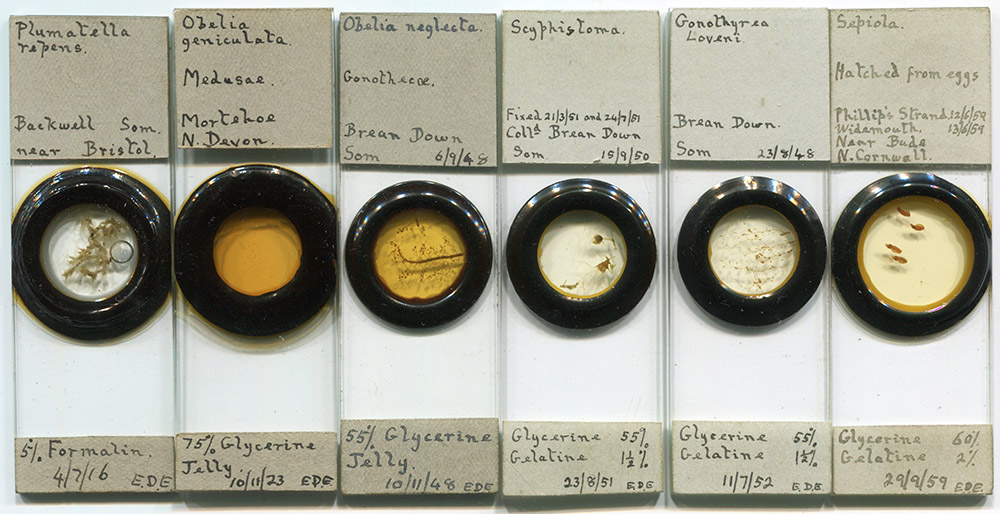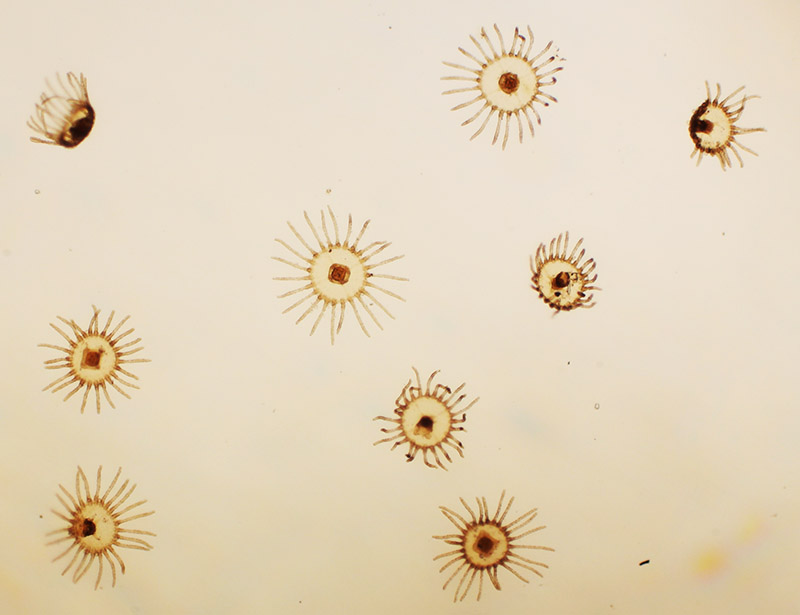Eric Doddrell Evens, 1893 - 1973
by Jacky McPherson
last updated January, 2018
Quite a few people value slides made by Eric Doddrell Evens. They are readily identifiable by their style and are generally signed with his initials, EDE. Generally, although not always, they are liquid mounts of soft-tissued animals and plants. As a man who took inordinate pains with his practical work, he produced many clean, beautifully-displayed slides, each framed with a shining black ring. The care he took ensured that the majority of these slides will have long lives. Little to no degradation is evident where the medium was gelatine based. Objects mounted in invert sugar compilations have tended to darken over the years, a chemical change that is characteristic of such media. He experimented with different adjuvants to improve colour stability, enable appropriate arrangement of the specimen and features such as pseudopodia, and to stabilise the pH of the mountant. A high proportion of the slides include details of the mountant formula.

Figure 1.
Examples of microscope slides that were prepared by Eric Evans. They are dated between 1916 and 1959, and all include notes on the mounting medium. They are primarily deep specimens, permitting the microscopist to view the specimens in natural three-dimensions.
Evens was born on April 21, 1893, in Bristol, England. He was fortunate that he grew up in the Avon region of England, an area that is rich in natural resources. Throughout his life, he made good use of his environment for collecting all sorts of flora and fauna from rocks, plants, ponds, and the sea-side. Luckily, this coast is composed of rocky beaches with numerous opportunities for rock pooling. He was certainly inspired by Philip Gosse’s A Naturalist’s Rambles on the Devonshire Coast and definitely consulted, among many other sources, Marion Newbiggin’s Life on the Seashore in his identification and description of the objects he found and mounted.
He was a member of both the Quekett Microscopical Club and The Postal Microscopical Society at different times in his life. In addition, the Bristol area had many specialist clubs and societies for caving, nature studies, and photography, with which he would have had connections. He also lectured on occasion at both the University and at the Merchant Venturer’s College, and had an honorary position at the Long Ashton Research Establishment in retirement. Bristol is a relatively small community and people of like minds mixed freely, sharing their interests.
He was an analytical chemist by profession, specialising in dye chemistry. Evans brought that expertise to his microscopy with a delicate touch and sensitive understanding of the differential staining. He frequently mounted the same subject stained with different staining combinations on the same slide, to demonstrate significant features. Many of his complex slides have a narrative showing changes over time or through a range of specimen life stages. He often achieved the multiple specimen arrangements by mounting the specimens on fractions of cover glass, which were subsequently aggregated under a single coverslip. If you have a slide with mixed presentation and there appear to be cracks in the hard mountant, then it is likely one of these mounts, not a fault in it.
Privately, he was a solitary man from a well-to-do Victorian family. His scientific interests dominated his daily life. There is no record of him driving or having a telephone. He used his bicycle and paddle-steamer ferries to travel around the area and the coast of Somerset and North Devon. Public transport was used to go further afield. He never married. Evans had few, if any, purely social activities, but was generous with his time and sharing his knowledge with interested parties.
Almost as engrossing as microscopy was his interest in the geology of the area. In the 1920s-40’s he took good photographs of the Caves in the Cheddar region, on quarter and half plate negatives. He also produced about 600 photographs of the area landscape, which record changes as it was developed during the 20th century. He collected Carboniferous fossils from the Pentland Sandstone quarry at Conygar, near to where he lived. Later in life, together with F.S. Wallis, he researched the sources of rocks used in stone implements found in the South-West of Great Britain, including Stonehenge.

Figure 2.
Medusae of Obelia geniculata that were collected near Mortehoe, North Devon. Prepared by E.D. Evans on November 10, 1923, using 75% glycerine jelly as mountant (see Figure 1, above). Photographed with a 3.5x objective lens and C-mounted digital SLR camera.
Respources
Bracegirdle, Brian (1998) Microscopical Mounts and Mounters, Quekett Microscopical Club, pages 36 and 136, and plate 16-P

